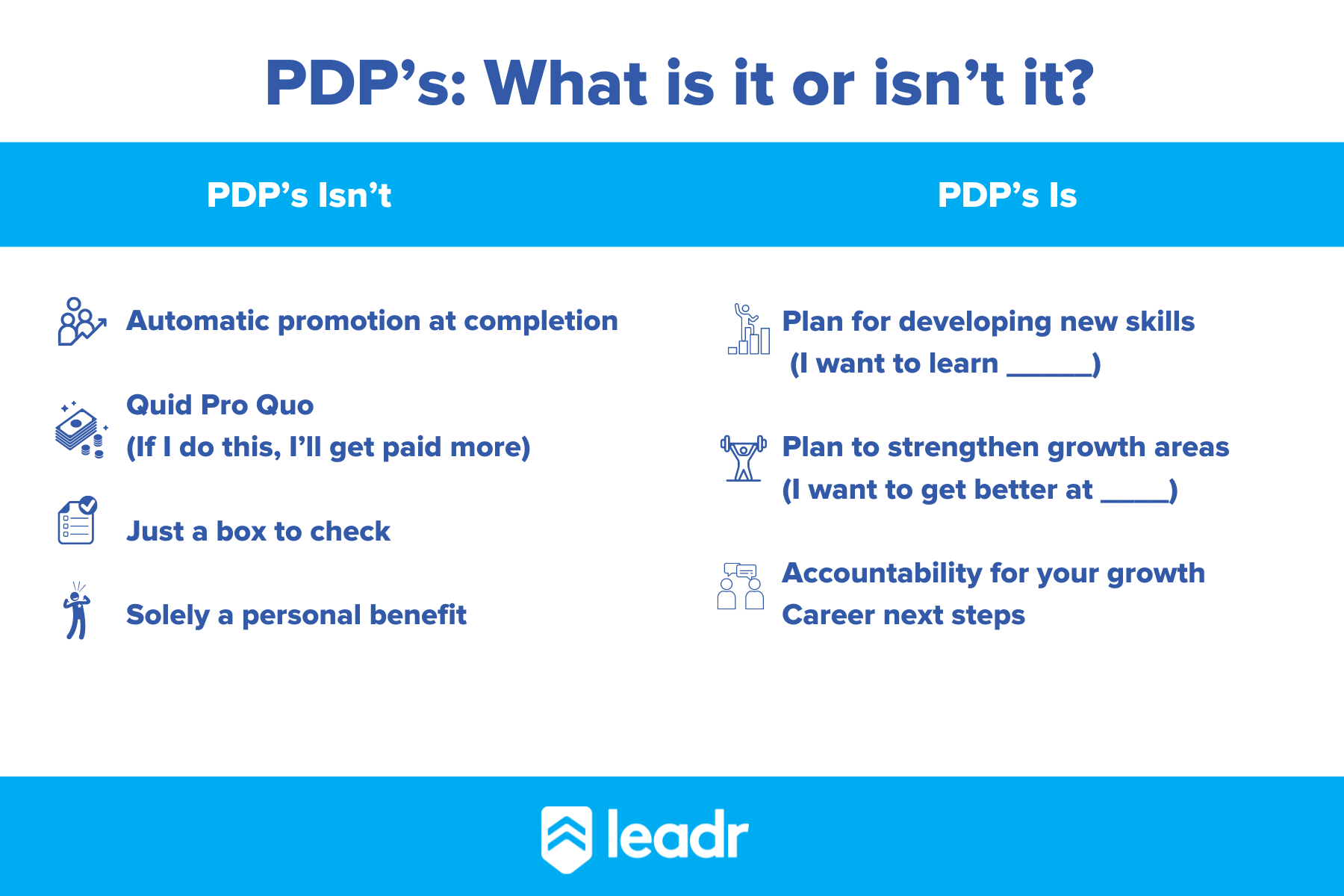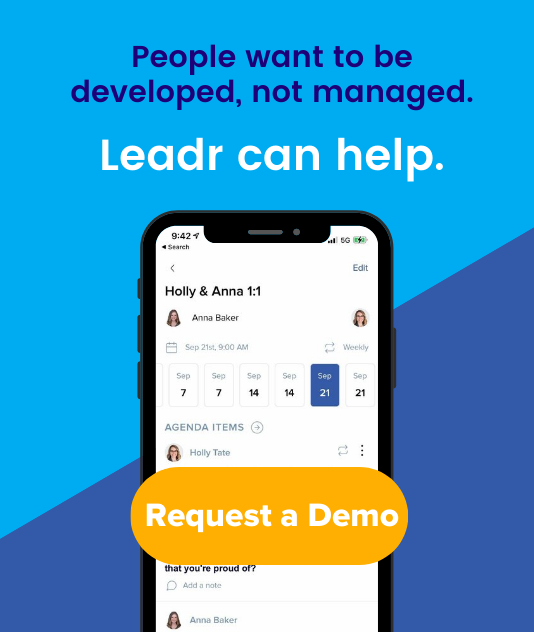How-to: Personalized Development Plans
Per Gallup, organizations who make a strategic investment in employee development are twice as likely to retain their employees, and report 11% greater profitability. Further, the number one reason employees provide for changing jobs is a lack of career growth opportunities in their workplace.
In our experience, building a clear process for employee development is easier than it sounds – and can make a significant impact on employee engagement and performance.
Starting with the concept of a formalized Personal Development Plan for key employees, and training your leaders on how to build these in partnership with their teams, is a great step in this direction.
What is a PDP?
A Personal Development Plan (PDP) is a strategic tool used by individuals to pursue personal or professional development. It requires reflecting on current strengths and areas of improvement, alongside attributes and achievements, as well as setting measurable goals.
To be clear, this isn’t just about moving up the “corporate ladder” or advancing to the next level of your role. While those are certainly capabilities of PDPs, the feature accounts for “Rockstars” (those who want to develop in their current role) as well as “Superstars” (those who want to advance to the next level of their career).
Having a PDP makes planning for a person’s development clear and progress easily trackable. The milestone-based approach of a PDP in Leadr creates a logical breakdown of a large plan into smaller pieces which are more easily achievable and allows for multiple checkpoints along the way.
The plan is owned by the person seeking development - they create and manage it throughout the process. We can’t force people to be developed, and those who aren’t ready or in a growth phase won’t be successful if a plan is “given” to them. By giving the person ownership of their plan, they are more likely to build a plan that meets their needs and they are more likely to see it through.
PDPs encourage visibility and mentorship by those who can help users achieve their desired outcome. By co-creating the plan with a Mentor, the plan structure can be curated and advised on to help make it effective. Viewers can also be invited to the plan to add comments and drive accountability.

Benefit of Personalized Development Plans to Users and Organizations
PDPs are beneficial to not only the person being developed, but also to the organization. Employees are able to create a documented, strategic plan for achieving their career goals and get the support they need to accomplish them. They are also able to plan for growth activities coming out of processes like reviews.
For the organization, employees who are developed and achieve their goals are significantly more likely to stay, decreasing turnover and increasing employee satisfaction and engagement. Additionally, PDPs increase engagement and provide a trackable record of achievement and skill development which can be utilized in succession planning, promotions, and in filling newly-created roles.
How to Design a Successful Personal Development Plan
Successful PDPs consist of several key components:
- Career Vision
Understanding the longer-range vision for the person’s career, perhaps 3-5 years out, is important for determining a plan to get there. Ask the person to seriously consider what they’re looking to accomplish. The following questions will help establish some clarity:
- In 3 years, what role would you like to have?
- Does the idea of leading others interest you?
- What tasks or projects do you lose track of time when working on?
- What makes you feel accomplished at work?
- Clear Outcomes
A single PDP should tackle shorter, more achievable outcomes toward the longer-range vision. These outcomes will become the competencies in the development plan. The following questions will help determine what to focus on:
- What’s one skill you’d love to learn more about?
- Do you dream about having a different role? What would that look like?
- What’s a skill you have that you don’t get to use as much as you’d like?
- Collaboration with Mentors
It’s important to utilize the experience of others in the organization to help the person achieve their plan. When advancing in their current job track or job family, or when gaining competence in their current role, the manager is often the best option. In other cases such as when changing career tracks or when working on a specialized skill area, another person may be the best fit. Shadowing during the plan is also an effective way to learn how others succeed in their role. Some questions to answer as you decide who the mentor of a plan should be are:
- Who can they work with or learn from to gain the level of competency needed?
- Who does that job now?
- Manageable Milestones
With a plan that’s 3-6 months in length, a single large goal or project isn’t likely to be successful. Breaking down the plan into monthly milestones at the largest is more effective to keep the person on track. Celebrate the wins along the way.
- Regular Touchpoints
The key to successful development is how you follow through once the plan is made. To ensure you’re set up for success, be sure you have intentional progress conversations each week in your 1:1 meetings with your mentor. You can also set up separate meetings specifically for the PDP.
Either way, here are the discussion points to hit along the way:
- Discuss Learnings. Ask intentional questions about what they’re taking away from each of their activities. That will help their learnings sink in and show your investment in their growth.
- Celebrate Successes. As they make progress toward their goal, be sure to acknowledge the hard work they’re putting into their development. What’s celebrated gets repeated.
- Provide Feedback. Whether it’s tips for time management as they’re working through their PDP or additional learning opportunities you uncover along the way, be sure you offer your team members feedback throughout the process. Remember: your primary role as a manager is to coach and enable your team.
- Don’t be Afraid to Change the Plan if you realize something else makes more sense.
Best Practices For Personalized Development Plans
Plan Length:
It’s good to identify your long-term career vision and where you eventually want to be in 3, 5, or 10 years, but for the purposes of an achievable PDP, it’s best to focus on 3-6 months in length at the most. Longer plans are typically more difficult to set up, more difficult to manage as things change over time, and harder to maintain effective momentum on.
Plan Scope:
Each plan is unique, but typically focusing on 5 or fewer competencies results in the best outcomes. More than 5 typically results in plans becoming large and unfocused. Some plans may only have 1 competency, and that’s ok. When the scope of the plan is targeted and achievable, it is significantly more likely to be completed. Users can have multiple plans to achieve larger goals over longer periods of time.
Who Should Be Involved:
- The Employee: The employee should be the primary decision maker when it comes to their PDP to ensure they’re fully invested in their success and growing in the areas they're most interested in.
- The Mentor: This person is often the employee’s direct manager, but could be another person within the organization who is best suited to guide and develop the employee within the scope of the given plan. If the employee is changing career tracks for example, the current manager may not be the best fit. The Mentor should collaborate with the employee on the plan and help determine the competencies and steps that will help them achieve their desired outcomes. The mentor’s ultimate role is to help enable the employee to succeed by providing support, asking intentional questions throughout the process, and providing feedback along the way.
- Executive Team - The executive team should be given the overview of each employee’s PDP have visibility into their team’s growth. This is important for leaders to know where their employee’s time and effort is going and to have opportunities to celebrate and encourage their growth.
Common Questions about Personalized Development Plans?
How should I structure a PDP when there aren’t opportunities for promotion within my team at the moment?
PDP’s are not just for promotion. As every leader knows there are a lot of factors involved when it comes to team members getting promoted in your organization including, position availability, tenure, and other candidates seeking the position. But that doesn’t mean PDP’s can’t be used to grow and develop you team in the seat they are in currently. PLus, by taking the time now to gain skills, grow and develop your team members are setting themselves up to be in a great position when the time for promotion eventually comes!
Additionally, studies show that when employees leverage strengths every day at work they are more fulfilled, which does wonders for your team and company culture as a whole.
“Gallup research shows that when employees know and use their strengths, they are more engaged (nearly six times more), have higher employee performance and are much less likely to leave their company.”
When should I (or an employee) create a PDP?
PDPs can be valuable in a number of different scenarios, throughout the various stages of your career. Some examples include:
- Career advancement: an employee seeking a promotion or new opportunity within their company, which requires honing key skills or performance such as leadership training, project management, or specific technical attributes.
- Skill enhancement: you may notice a gap in your skillset that limits your effectiveness, or future opportunities for advancement. A PDP can help create external accountability to improve in these areas, such as practicing public speaking, mastering a new software, or enhancing your data analysis skills.
- Performance improvement: when an employee is struggling to meet the expectations of success in their position, the more clearly you can articulate the missed expectation and the opportunities for improvement, the more likely they are to be able to bridge that gap and find long-term success in their role.
- Career transition: individuals looking to transition into a different role or function within the organization can often share the benefit of their learning with the organization
Ask yourself this question: Are they fine where they are at or do they not want to grow? Hopefully the answer is they DO want to grow, just not out of the role they are in. These are some of your best employees. Structure their PDP’s for personal growth, not necessarily career growth. If the answer is they don’t want to grow, you may need to go deeper and look at their over all performance. Are they where you need them to be? If not, consider a PDP for performance improvements.
How much time and resources will adding PDP's into our workflow take?
The time and resources required to add Personalized Development Plans (PDPs) into your workflow can vary depending on several factors, including the size of your organization, the current processes in place, and the level of customization needed for the PDPs. Some PDP’s are simple, taking only a few minutes and a conversation between the employee and mentor. Others involve multiple levels of management, budget approvals and a more significant lift.
We have very high turnover, how do PDPs fit in that environment?
While it may seem that PDP’s in high turnover organizations feels like a lot of effort for not a lot of reward, the opposite is actually true. In an environment with high turnover, Personalized Development Plans (PDPs) can play a crucial role in several ways:
- Retention: By offering tailored growth opportunities, PDPs can increase employee engagement and satisfaction, potentially reducing turnover.
- Skill Development: PDPs focus on improving skills, which can make employees more valuable to the organization and less likely to leave.
- Succession Planning: PDPs can identify and develop future leaders within the organization, reducing the impact of turnover on key positions.
- Knowledge Transfer: PDPs can facilitate the transfer of knowledge and skills from outgoing employees to new hires, reducing the disruption caused by turnover.
Overall, integrating PDPs into a high-turnover environment can help create a more stable and engaged workforce.
Further Reading on PDP’s
Interested in learning more about personal development plans? The following resources are available.
Books:
- "The 7 Habits of Highly Effective People" by Stephen R. Covey - This classic book offers practical advice on personal development and effectiveness, including goal setting and creating a personal mission statement.
- "StrengthsFinder 2.0" by Tom Rath - This book introduces the concept of identifying and leveraging your strengths for personal and professional development.
- "Mindset: The New Psychology of Success" by Carol S. Dweck - Dweck's research on the growth mindset versus the fixed mindset can be valuable for understanding personal development and learning how to set and achieve goals.
- "Atomic Habits: An Easy & Proven Way to Build Good Habits & Break Bad Ones" by James Clear - This book provides practical strategies for behavior change, which can be useful for implementing personal development plans.
- "Drive: The Surprising Truth About What Motivates Us" by Daniel H. Pink - Pink explores the science of motivation and how it relates to personal development and goal achievement.
Websites:
- Harvard Business Review (hbr.org) - HBR offers articles and insights from leading experts in business and management, including topics related to personal development, goal setting, and career advancement.
- TED Talks (www.ted.com) - TED Talks feature inspiring talks by thought leaders on a variety of topics, including personal development, motivation, and achieving goals.
- LinkedIn Learning (www.linkedin.com/learning) - LinkedIn Learning offers online courses on personal development topics, such as time management, leadership skills, and career advancement strategies.
Share this
You May Also Like
These Related Stories

How-to: The Guide to Setting Goals that Actually Work

5 Proven Tips to Develop Employees in Fast-Paced, High Turnover Industries




No Comments Yet
Let us know what you think